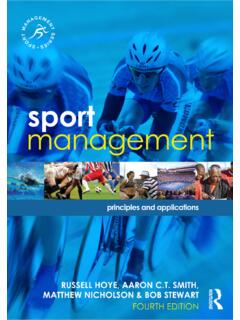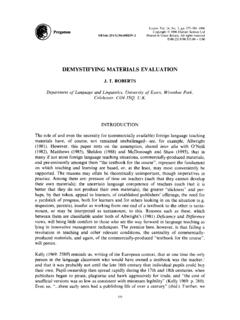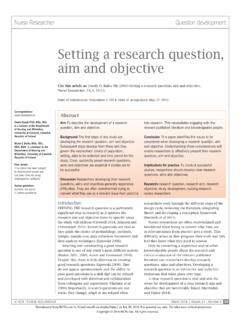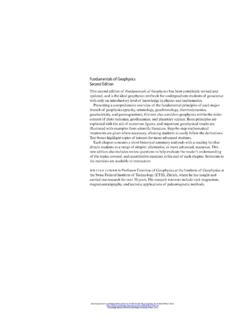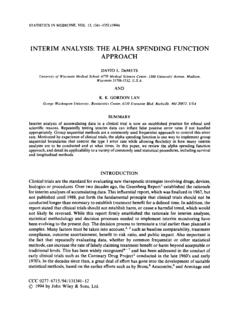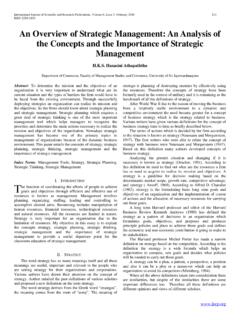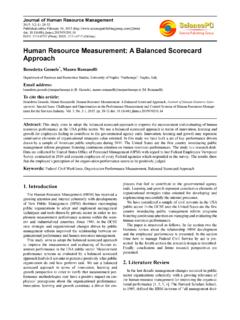Transcription of Sport Facility Operations Management
1 Sport Facility Operations Management This page intentionally left blank Sport Facility Operations Management Eric C. Schwarz, Stacey A. Hall and Simon Shibli AMSTERDAM BOSTON HEIDELBERG LONDON NEW YORK. OXFORD PARIS SAN DIEGO SAN FRANCISCO. SINGAPORE SYDNEY TOKYO. Butterworth-Heinemann is an imprint of Elsevier Butterworth-Heinemann is an Imprint of Elsevier The Boulevard, Langford Lane, Kidlington, Oxford OX5 1GB, UK. 30 Corporate Drive, Suite 400, Burlington, MA 01803, USA. First edition 2010. Copyright 2010 Elsevier Ltd. All rights reserved No part of this publication may be reproduced, stored in a retrieval system or transmitted in any form or by any means electronic, mechanical, photocopying, recording or otherwise without the prior written permission of the publisher Permissions may be sought directly from Elsevier's Science & Technology Rights Department in Oxford, UK: phone (+44) (0) 1865 843830; fax (+44) (0) 1865 853333.
2 Email: Alternatively you can submit your request online by visiting the Elsevier web site at , and selecting Obtaining permission to use Elsevier material Notice No responsibility is assumed by the publisher for any injury and/or damage to persons or property as a matter of products liability, negligence or otherwise, or from any use or operation of any methods, products, instructions or ideas contained in the material herein. Because of rapid advances in the medical sciences, in particular, independent verification of diagnoses and drug dosages should be made British Library Cataloguing in Publication Data A catalogue record for this book is available from the British Library Library of Congress Cataloging-in-Publication Data A catalog record for this book is available from the Library of Congress ISBN: 978-1-85617-836-5.
3 For information on all Butterworth-Heinemann publications visit our web site at Printed and bound in Great Britain 10 11 12 10 9 8 7 6 5 4 3 2 1. Contents Preface vii Acknowledgments, dedications, epigraphs xiii About the authors xv Prologue 1. 1 Introduction to Sport Facility Operations Management 3. Section One Pre- Management and Pre-Operational Issues 11. 2 Ownership structures 13. 3 Financing Sport facilities 31. 4 Planning, design, and construction processes 51. Section Two Implementation of Management and Operational Strategies 65. 5 Organizational Management 67. 6 human resource Management 83. 7 Financial Management 103. 8 Operations Management 123. 9 Legal concerns for owners and managers 143. Section Three Ancillary Issues in Management and Operations 153. 10 Facility marketing Management 155.
4 11 Event planning in Facility Management 171. vi Contents 12 Risk assessment in Facility Management 181. 13 Security planning for Facility Management 197. Section Four Effectiveness of Management and Operations 217. 14 Performance Management and benchmarking 219. Glossary 243. Further reading 259. Index 273. Preface Sport facilities of all shapes and sizes are an ingrained part of global Sport Management culture. As such, it is inevitable that students who enter into the field of Sport Management will interact with the Management and Operations of a Sport Facility at some point during their career. This book is being published with the Sport Management educator and student in mind, specifically aimed at those Sport Management programs that require a Facility Management unit as a part of their curriculum.
5 Most Sport Facility Management books currently on the market go into the basic theoretical framework of Sport Facility Management , but fail to relate many of the concepts to the traditional Operations Management units taught in business Management . In addition, there is limited relevant prac- tical professional experience infused through the books. Finally, there is a lack of identification, interpretation, and recognition of the individual differences in managing and operating facilities across the globe. Sport Facility Operations Management : A Global Perspective strives to address these limitations by bringing the most comprehensive and significant Sport Facility Management textbook to market that addressed this important area of Sport Management from a global perspective. This is crucial in textbooks within this field of study, as the Sport industry is truly global, and education must reflect this.
6 This book brings together three authors with significant experience in teaching Sport Management in the United States, Europe, and Australia; conducting research related to Sport Facility Management and Operations around the globe, and having practical experience in Sport Facility Operations Management . With this background, the purpose of the textbook is to provide the theoretical foundation for Sport Facility Operations Management , and would be supple- mented both in the text and in the appendices with practical applications via case study scenarios and functional documentation that can be utilized by the Sport Facility manager. In addition, each author would infuse research and experiences from Sport facilities around the world (North America, Europe, Middle East/. Asia, Australia, and New Zealand) to ensure that a global perspective for the textbook is achieved.
7 The initial chapter of the book serves to provide an overview of Sport Facility Operations Management , including a basic review of those topics commonly covered in an introductory Sport Facility Operations Management course. The remainder of this text will provide the reader a framework understanding viii Preface of Sport Facility Operations Management from a global perspective by: (1) con- necting the behind-the-scene concepts that must be understood before even entering into Management and Operations of Sport facilities, (2) implementing Management and Operations in Sport facilities and the ancillary and support issues inherent to Sport Facility Operations Management , and (3) providing methods for measuring and evaluating the performance of Operations and Management for Sport facilities that aid in the successful implementation of activities that meet the needs, wants, and desires of users.
8 Section I Pre- Management and pre-operational issues Ownership structures The reader will be presented with the various business, ownership, and gover- nance structures for Sport facilities across the globe. Sport Facility owners must first understand the legal authority under which the Sport Facility can operate as a business, including as a sole proprietorship, a partnership, or under a number of forms of corporations. At the same time, the Sport Facility owners must determine how they want to structure their Sport business either as a public entity, a non-profit business, or a commercial enterprise; and also whether the governance structure will be as a public entity, a private entity, a public private partnerships, or under a voluntary structure. In addition to these structures, the reader will be presented with models of organizational effectiveness that can assist in efficiently managing the ownership structure.
9 Financing The reader will gain an appreciation of the intricacies of financing Sport facilities as related to various business issues, the costs of ownership, life-cycle costing, cost-effectiveness/efficiency, and the principles of economic impact analysis. The understanding of these issues will then allow the reader to recognize and understand the different sources of financing to be used for Sport facilities, including public sector funding, private sources of revenue, public private partnerships, and the influence of the voluntary sector. Planning, design, and construction processes The reader will learn about the various stages of the planning, design, and construction processes, including preliminary planning; the development of design; actual construction; and preparation for training and Management of facilities.
10 By understanding these issues in advance, the reader will have a stronger conceptual underpinning of the Management framework applied to Sport facilities, and be able to more clearly connect that knowledge with the implementation processes inherent to Management and Operations of Sport facilities. Preface ix Section II Implementation of Management and operational structures Organizational Management The reader will learn how to distinguish, identify, and classify the important concepts of organization Management as related to individual and group behavior in Sport facilities. These will include the principles of motivation, stress Management and well being, leadership, use of power and authority, politics, conflict Management , decision making, and problem solving. The reader will then be able to connect these concepts with various leadership and organiza- tional Management concepts that affect international and global Sport Facility Operations , including determinants of organizational culture and change, and the effects of cultural diversity and global organization behavior.
